Understanding and Addressing Slow Running Drains
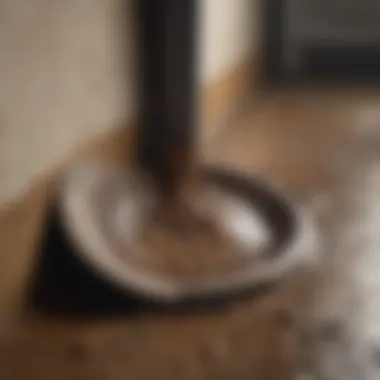
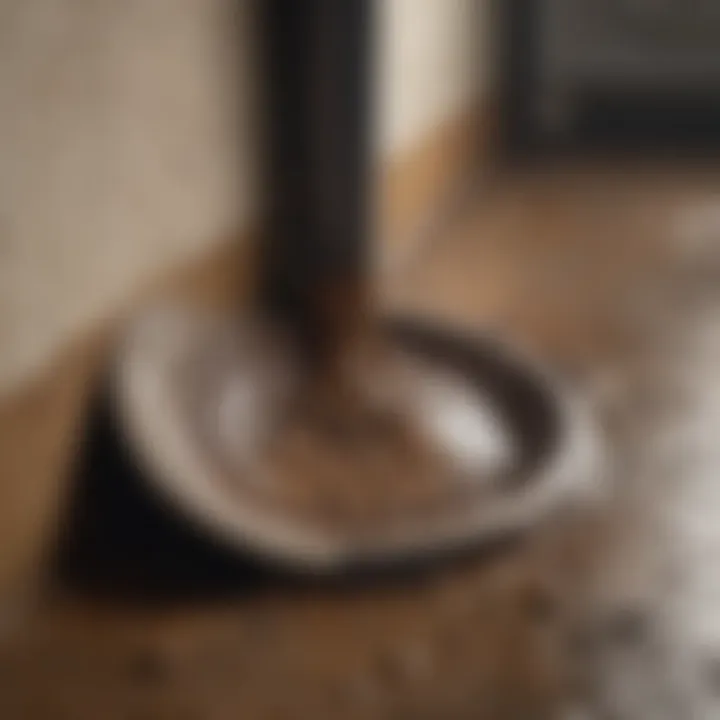
Intro
Slow-running drains can be both frustrating and concerning for homeowners and renters alike. When water struggles to flow, it indicates underlying issues needing attention. Understanding the causes behind these pesky plumbing problems is essential for effective solutions. This article offers an in-depth examination of slow drains, providing practical advice for diagnosis and repair, as well as preventive measures to avoid future complications.
The relevance of this topic stretches further than mere inconvenience. Slow drains may lead to worsening plumbing issues, potential health hazards from stagnant water, and increased repair costs if not addressed promptly. Homeowners must stay vigilant by recognizing early signs and taking action to maintain optimal drain function.
In the following sections, we will explore various aspects related to slow-running drains, including:
- Key causes behind drainage issues
- Effective solutions for fixing slow drains
- Preventive measures for maintaining clear drainage systems
With this guide, homeowners, renters, and enthusiasts will be equipped with the knowledge necessary to tackle slow drains effectively.
The Fundamentals of Drainage Systems
Understanding drainage systems is essential for effective home maintenance. Delving into the fundamentals helps homeowners identify issues quickly and implement solutions before they escalate. Efficient drainage systems prevent water buildup, minimize damage, and ensure a healthy living environment. The intricacies of drainage systems include several types and essential components, each playing a crucial role in overall functionality.
Types of Drainage Systems
There are various types of drainage systems, each designed to address specific needs and scenarios. The main categories include:
- Surface Drainage: This type captures excess rainwater pooling on the ground. It often involves ditches, trenches, or sloped surfaces that direct water away from buildings.
- Subsurface Drainage: These systems are buried below ground and remove groundwater from soil. They manage soil moisture to prevent plant roots from rotting too much.
- Sump Pump Systems: Common in basements, these devices collect water and pump it away from the foundation. They help prevent flooding in lower levels of homes.
- Stormwater Systems: Designed for urban areas, these integrate various methods to manage runoff from precipitation to prevent flooding and protect water quality.
Each type has unique applications and benefits that can drastically affect a home's structural integrity and efficiency.
Components of a Drainage System
The effectiveness of a drainage system relies on its components, which serve to channel, filter, and store water. Key components include:
- Pipes: These are the veins of any system. They transport water from where it collects to drainage points. Their diameter and material affect flow rate and durability.
- Catch Basins: Positioned at low points, catch basins trap debris and sediment, allowing cleaner water to flow into pipes.
- Grates and Screens: Found at surface drains, these prevent larger debris from entering the system, reducing clogs.
- Manholes and Cleanouts: These allow access to the drainage system for inspections and maintenance, vital for addressing blockages.
An understanding of these components assists in recognizing potential problems and planning for effective solutions, thereby supporting overall home maintenance strategies.
Identifying Slow Running Drains
Identifying slow running drains is a crucial step in maintenance and ensuring the smooth operation of your household plumbing system. It's important because recognizing the early signs can help prevent larger, more costly issues down the line. Homeowners and renters should be attentive to changes in drainage behavior as they could indicate further complications. Moreover, understanding how to pinpoint slow drains enhances overall home management.
Common Symptoms of Slow Drains
Slow drains may present various symptoms indicating their problematic state. Being aware of these can aid in swift action:
- Water pools in sinks or bathtubs: If water does not drain as expected after use, this indicates a slowdown.
- Foul odors: A stagnant drain is often a breeding ground for bacteria, leading to unpleasant smells.
- Gurgling sounds: These noises might signal air trapped by blockages, hinting at a drainage issue.
- Frequent backups: If your drains back up often, this could point to a persistent or growing problem.
- Changes in flow: Sudden changes in how quickly water drains can mean an underlying issue.
If you notice one or more of these symptoms, you may need to address the issue before it escalates.
When to Seek Professional Help
While some drainage solutions are DIY friendly, it's vital to know when to call in professionals. Certain situations can complicate the repair process, and experienced plumbers can often provide a better resolution. Here are some guidelines to consider:
- Persistent problems: If slow drains remain after several DIY attempts, it may signal a deeper issue within the plumbing system.
- Extensive backups: Severe backups that affect multiple drainage areas often require expert intervention.
- Unusual behavior: If multiple drains show signs of problems, this can indicate a systemic issue.
- Potential for damage: If you suspect there could be pipe damage or leaks, a professional assessment is prudent.
- Time constraints: Sometimes, it is simply more efficient to let a professional handle it.
By recognizing these circumstances, homeowners can prevent potential damage and ensure their plumbing system remains in sound condition.
Underlying Causes of Slow Running Drains
Understanding the underlying causes of slow running drains is crucial for homeowners looking to maintain their plumbing systems effectively. Recognizing these causes allows for timely intervention, preventing more extensive and costly repairs down the line. Slow drains can manifest for various reasons, and addressing these specific elements not only restores function but also enhances the longevity of the drainage system. Factors such as regular maintenance, the materials used and installation practices significantly influence the efficacy of drainage systems.
Clogs and Blockages
Clogs and blockages represent one of the primary causes of slow draining. Hair, soap, grease, and food particles can amass in pipes, hindering the flow of water. This accumulation can occur gradually or very quickly, depending on several factors such as usage and the type of materials in the drainage system.
- Prevention is Key: To prevent clogs, be vigilant about what goes down the drain. Using drain screens can be effective in minimizing the entry of hair and large food particles.
- Routine Cleaning: Regularly cleaning drains can also help. Methods such as boiling water, baking soda, or vinegar can effectively break down minor blockages.
It is advisable to identify and clear blockages as soon as possible. Ignoring minor slowdowns can lead to severe obstructions and potentially burst pipes.
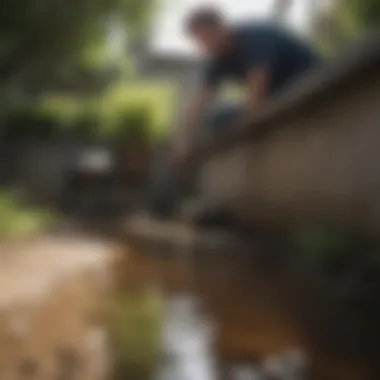
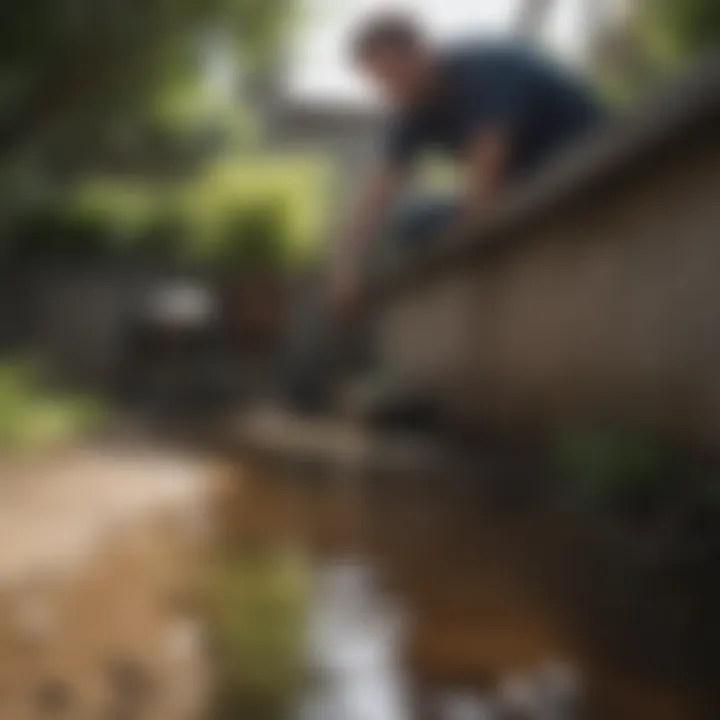
Pipe Damage and Deterioration
Another significant contributor to slow drains is pipe damage or deterioration. Over time, pipes may corrode or become misaligned, leading to restrictions in water flow. Factors contributing to this damage often include:
- Age of the Piping: Older homes often have galvanized or cast iron pipes, which are more susceptible to corrosion.
- Tree Roots: Roots can invade pipe systems, causing blockages and breaks. This is particularly true for clay pipes, which are prone to intrusion.
- Temperature Fluctuations: Extreme temperature changes can cause pipes to expand and contract, leading to cracks and leaks.
Detecting pipe damage early on is vital. Homeowners should consider routine inspections, particularly in older homes, to assess the condition of the plumbing system.
Improper Installation
Improper installation of drainage systems can lead to multiple issues, including slow running drains. If pipes are not correctly aligned or if the slope is incorrect, water will not flow efficiently. Common errors during installation include:
- Incorrect Slope: Proper drainage systems should be graded to allow gravity to assist in flow. An inadequate slope can cause water to pool, leading to potential blockages.
- Poor Connections: Joints that are not securely connected can allow debris to enter the system or create leaks.
To avoid these installation issues, it is critical to hire qualified professionals for any drainage work. Adhering to building codes and best practices ensures long-lasting functionality in drainage systems.
Common Materials That Cause Drainage Issues
Understanding the common materials that lead to drainage issues is crucial. These materials can gradually build up within your plumbing system, creating blockages and reducing the efficiency of your drains. Focusing on these materials allows homeowners to implement preventative measures before serious issues emerge. This section examines the three most prevalent culprits: hair and soap residue, food waste and grease, as well as foreign objects.
Hair and Soap Residue
Hair is a significant contributor to slow drains, especially in bathrooms. When hair combines with soap residue, it creates clumps that can easily obstruct water flow. Soap, particularly traditional bar soap, tends to leave behind scum that adheres to the inner walls of pipes, further narrowing the space that water can travel through.
- Regular maintenance: Removing hair from drains on a regular basis can prevent buildup. Consider installing drain covers that catch hair before it enters the plumbing system.
- Proper cleaning products: Opt for liquid soaps and shampoos that dissolve more easily than solid soaps. This practice reduces the likelihood of residue clinging to pipes.
Food Waste and Grease
Another common contributor to drainage problems is food waste and grease. When cooking, oils can be poured down the drain, solidifying as they cool. This creates a thick layer that clogs pipes over time. Similarly, bits of food left on dishes can accumulate in residential plumbing, leading to blockages.
- Disposal habits: Encourage proper disposal techniques for grease and oily food waste. Use a container to collect grease and dispose of it in the trash instead of pouring it down the sink.
- Garbage disposal maintenance: If you use a garbage disposal, regularly run cold water while using it. This practice helps keep food particles moving through pipes.
Foreign Objects
Foreign objects are often the most unexpected cause of drainage issues. Items such as toys, dental floss, or sanitary products can accidentally be flushed or washed down, causing immediate and significant blockages. Detecting these issues can be more challenging, especially if the items are lodged deep within the plumbing system.
- Awareness and education: Make sure everyone in your household understands what can and cannot go down the drains. This can save time and money on repairs down the line.
- Routine inspections: Regularly check for any visible signs of blockage in your drains. This can help identify potential issues before they exacerbate.
"By being informed about common materials that cause drainage issues, homeowners can take actionable steps to maintain clear and efficient plumbing systems."
Methods for Resolving Slow Running Drains
Addressing slow running drains is crucial in maintaining a functional plumbing system. Over time, drains can accumulate debris, causing water to back up and flow inefficiently. Thankfully, there are various methods available to tackle these issues effectively. Understanding these methods will not only help in resolving existing problems but also prevent future occurrences. Homeowners and renters alike can benefit from knowing how to handle these concerns in order to maintain a smooth-running drainage system.
DIY Solutions for Minor Clogs
For minor clogs, a few simple DIY solutions can be quite effective. These strategies often require common household items and can save time and money.
- Boiling Water: Pouring boiling water down the drain can help dissolve grease and soap buildup. It’s a simple solution but effective for light clogs.
- Baking Soda and Vinegar: This combination creates a chemical reaction that can break down debris. Pour half a cup of baking soda followed by half a cup of vinegar into the drain. Let it sit for at least thirty minutes, then flush with hot water.
- Wet/Dry Vacuum: If you have access to a wet/dry vacuum, it can be useful to suction out clogs. Be cautious and follow the manufacturer instructions.
These methods are easy to perform and do not require special equipment. Homeowners should consider trying these before turning to more aggressive solutions.
Chemical Drain Cleaners: Pros and Cons
Chemical drain cleaners can be an option for more stubborn clogs. These products are designed to dissolve blockages, but they come with important considerations.
Pros:
- Quick Results: They often work fast, providing immediate relief from slow draining issues.
- Availability: Most hardware stores stock a range of chemical drain cleaners, making them accessible for quick fixes.
Cons:
- Corrosive Nature: Many of these cleaners contain harsh chemicals. Prolonged use can damage pipes, especially older plumbing systems.
- Environmental Impact: The chemicals can harm local ecosystems if they leak into waterways.
It is critical to read labels carefully and understand the potential effects of using these cleaners in your system. While they are effective, they should not be relied on as a long-term solution.
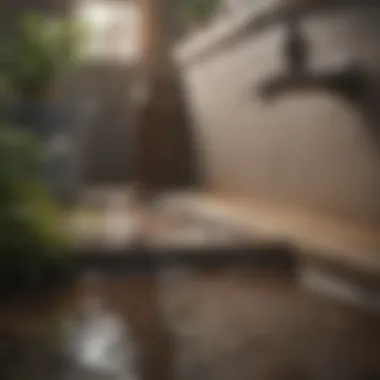
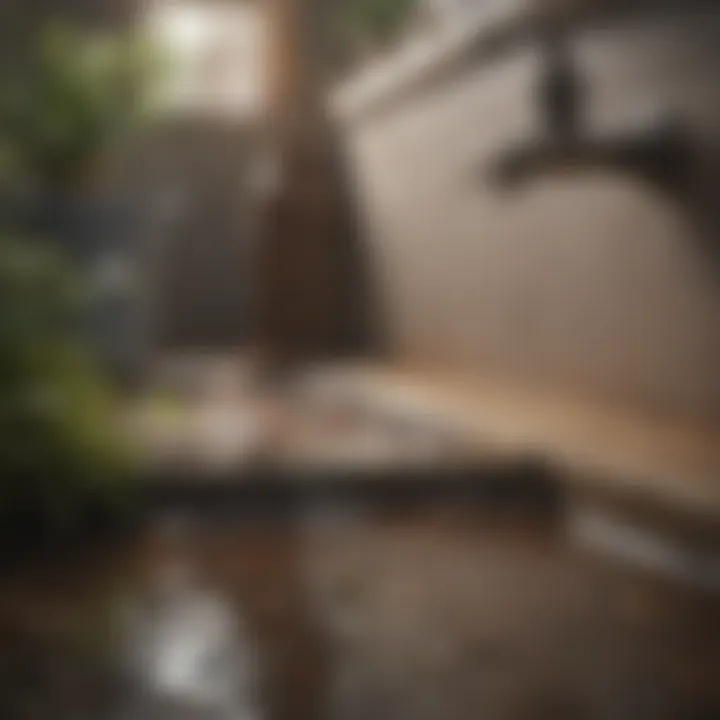
Using a Plumber's Snake
A plumber's snake, also known as a drain auger, is a tool designed to remove clogs deeper within the plumbing system. This tool is particularly relevant when home remedies fail. The plumber’s snake can reach blockages that are beyond the reach of standard cleaning techniques. Using this tool requires careful attention.
- Insert the Snake: Place the end of the snake into the drain. Gently push it through until you feel resistance, indicating a blockage.
- Turn the Handle: Rotate the handle to allow the snake to bore through the clog. This helps to break it apart or pull it out.
- Withdraw and Clean: Once the blockage is cleared, remove the snake slowly and clean any debris that may have come out. Following this, flush the drain with water to ensure it flows freely.
The plumber’s snake is an effective tool that can be used by homeowners willing to take on a hands-on approach to their plumbing issues. However, if the clog persists, it may be necessary to consult with a professional.
Addressing slow running drains quickly can prevent larger plumbing issues in the future. Being proactive is the key.
Preventative Measures for Drain Maintenance
Preventative measures for drain maintenance are crucial to ensure the longevity and functionality of your drainage system. Taking proactive steps can help avert the hassles of slow-running drains and costly repairs later on. By implementing certain ongoing practices, homeowners and enthusiasts can maintain a healthy drain environment. In this section, we will delve into the essential routines and installations that can foster an efficient drainage system.
Regular Cleaning Routines
Establishing a regular cleaning routine for your drains is a fundamental aspect of preventative maintenance. Scheduling periodic cleanings can aid in the removal of buildup from various materials such as hair, soap residue, and food particles. Consider the following benefits:
- Reduced Blockages: Regular cleaning prevents the accumulation of debris that leads to slow drains or clogs.
- Prolonged Lifespan: A well-maintained drainage system often lasts longer, requiring fewer repairs and replacements.
- Hygiene: Keeping drains clean minimizes bad odors and reduces the risk of attracting pests.
To effectively manage this routine, you might want to:
- Use a mixture of baking soda and vinegar to clear minor buildups. Allow it to sit for several minutes before flushing with hot water.
- Periodically remove any visible debris from the drain cover and the surrounding areas to prevent them from entering the drainage system.
- Clean pipes using an appropriate tool like a hose or a plumbing snake to dislodge stubborn debris.
Installing Drain Screens
Drain screens serve as an effective barrier against unwanted debris entering your plumbing system. Installing these screens at key locations, such as kitchen sinks and bathroom drains, can significantly enhance drain performance. Consider the advantages of implementing drain screens:
- Physical Barrier: Screens catch larger particles and prevent them from causing blockages within the pipes.
- Easy Maintenance: Cleaning drain screens is simple and can usually be done on a weekly basis, thus ensuring ongoing performance.
- Cost-Effective Solution: Instead of dealing with expensive repairs for blockages, investing in screens can save money in the long run.
When choosing drain screens, look for:
- A design that fits snugly over the drain opening to ensure maximum effectiveness.
- Durable materials that resist rust and wear, especially in areas exposed to moisture.
"Installing drain screens can be a simple yet highly effective method in maintaining an efficient drainage system."
By integrating regular cleaning routines and the use of drain screens into your maintenance practices, you can ensure that your drainage system functions smoothly and efficiently. These preventative measures not only enhance performance but also contribute to the overall health of your plumbing infrastructure.
The Importance of Professional Drain Services
Professional drain services play a crucial role in maintaining the functionality and longevity of drainage systems. Though many homeowners may attempt to resolve issues on their own, the complexity of drainage systems often requires specialized knowledge and tools. Employing professionals can ensure that the root causes of slow running drains are addressed effectively, minimizing the risk of recurring problems.
For one, professional drain services can provide a thorough and accurate diagnosis of the issue. While DIY solutions might fix surface-level problems temporarily, they do not guarantee that deeper issues are resolved. Blockages located deeper within the piping may require specialized equipment, such as hydro-jetting or high-resolution cameras, to locate and eliminate the source of the blockage.
Additionally, professionals can offer insights into more significant underlying issues that may affect the drainage system's overall health.
Some key benefits of hiring professionals include:
- Expertise: Trained technicians understand the intricacies of various drainage systems and can handle unique cases.
- Advanced Equipment: Access to tools that the average homeowner may not possess, like video inspection tools or high-pressure cleaning devices.
- Long-term Solutions: Professionals can identify issues that might not be apparent, preventing future problems and added expenses.
Another critical aspect is the prevention of property damage. Slow running drains can lead to water accumulation, which poses a risk not only to the drain itself but also to surrounding structures. Water damage can result in mold growth, structural problems, and a myriad of other issues, leading to costly repairs. This brings us to our next point:
When to Hire Professionals
Understanding when to seek professional help is crucial. Homeowners should consider hiring professionals under the following circumstances:
- Persistent Problems: If slow drains persist after multiple attempts at DIY solutions, it might indicate a deeper issue that needs expert attention.
- Multiple Clogs: When more than one drain is slow or clogged simultaneously, this could point to a main line issue that requires immediate professional intervention.
- Unusual Sounds or Smells: Gurgling sounds or foul odors emanating from the drains may signal serious obstructions or issues in the drainage system.
- Older Systems: Homes with older plumbing fixtures or vintage construction may benefit from the knowledge and experience that professionals bring, especially in assessing the overall integrity of the plumbing system.
Benefits of Preventative Inspections
Integrating regular preventative inspections into drain maintenance can be a game-changer for homeowners. Some advantages include:
- Early Issue Detection: Inspections can catch small problems before they escalate into major repairs.
- Maintenance of Drain Health: Regular checks help maintain optimal functionality throughout your plumbing system.
- Cost Savings: Addressing issues early prevents costly repairs down the line. A small blockage cleared early is far cheaper than dealing with a backup that floods your home.
- Peace of Mind: Knowing your drainage system is routinely inspected offers reassurance that your home is protected against potential disasters.

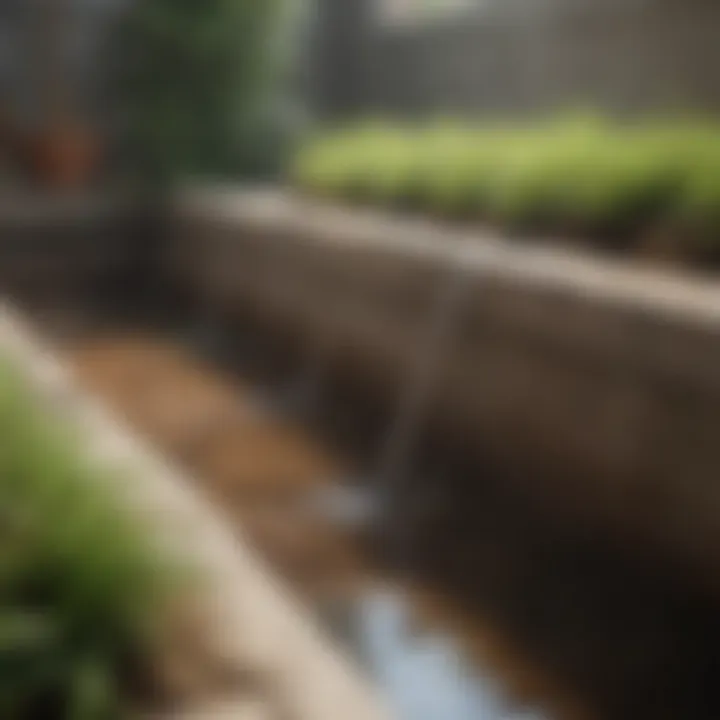
"Preventative maintenance is key to avoiding the expense and hassle of major repairs. A proactive approach is always better than a reactive one."
Innovative Solutions in Drainage Technology
Innovative solutions in drainage technology represent a significant advancement in how we manage and maintain our drainage systems. This technology not only addresses current issues more effectively but also prevents future problems. With actual and potential challenges related to slow-running drains, adopting these innovations can be a key strategy for homeowners and professionals alike.
These solutions often integrate smart systems and advanced cleaning methods. By embracing these technologies, individuals can experience clearer drains, reduced need for frequent maintenance, and overall improved efficiency of their plumbing systems. The convenience brought by these innovations often leads to long-term cost savings.
Smart Drain Systems
Smart drain systems leverage modern technology to enhance drainage performance. These systems incorporate sensors and smart technology to monitor flow rates and identify blockages in real-time. Such proactive measures mean that issues can be addressed before they escalate into significant problems.
Benefits of Smart Drain Systems:
- Real-Time Monitoring: Homeowners receive alerts for potential blockages as they happen. This ensures timely intervention.
- Data Analysis: These systems can provide usage data that help in understanding stress points in drainage systems.
- Remote Access: Some advanced models allow users to monitor their drainage systems remotely via mobile applications.
- Integration with Home Systems: Many smart drain systems can integrate with existing home automation setups.
Using smart drain systems can significantly alleviate homeowner stress. However, initial costs for installation can be a consideration before adoption.
Advanced Cleaning Technology
Advanced cleaning technology has evolved from traditional methods of clearing drains. New equipment utilizes high-pressure water jets and machine-assisted cleaning processes that enhance efficiency while minimizing damage to pipes. This technology is ideal for dealing with stubborn blockages that do not respond well to conventional methods.
Advantages of Advanced Cleaning Technology:
- Effective Removal of Clogs: These methods can address deep-rooted clogs caused by grease, hair, and other materials.
- Non-Invasive Processes: Unlike chemical treatments, many advanced tools use physical force to clean without damaging materials.
- Environmental Considerations: Many cleaning technologies are eco-friendly, often using only water or minimal chemicals, helping to protect the environment.
- Long-Lasting Results: The thoroughness of advanced cleaning can lead to fewer recurring drainage issues, making it a worthwhile investment.
Environmental Considerations in Drain Maintenance
Considering environmental factors in drain maintenance is essential for both ecological balance and overall drain functionality. When homeowners and property managers neglect these factors, the consequences can be detrimental not only to plumbing systems but also to the environment. Many common cleaning products and solutions used for drain maintenance contain harsh chemicals that may harm aquatic life and disrupt local ecosystems. Understanding these impacts can lead to more thoughtful choices regarding drainage upkeep, thus fostering a healthier relationship between daily household tasks and environmental stewardship.
Eco-Friendly Drain Cleaning Solutions
Eco-friendly drain cleaning solutions offer a sustainable alternative to traditional methods. These solutions can effectively clear minor clogs and maintain clear drains without introducing harmful substances into the plumbing system or surrounding environment.
- Baking Soda and Vinegar: This simple homemade mixture can work well to dissolve buildup in drains. Pour half a cup of baking soda followed by half a cup of vinegar into the drain. Allow it to fizz for at least 30 minutes, then flush with hot water. This method is effective and reduces reliance on harsh chemicals.
- Salt and Hot Water: This combination is another effective, eco-friendly solution. Pour a cup of salt down the drain followed by boiling water. This can help dissolve grease and maintain clear pipes.
- Enzyme Cleaners: These products utilize natural enzymes to break down organic matter in pipes without damaging the plumbing or the environment. They provide a safer and more sustainable option compared to chemical cleaners.
Utilizing such eco-friendly methods can provide effective drain cleaning while also helping to minimize harmful environmental impacts.
Impact of Chemicals on Drainage Ecosystems
The usage of chemical drain cleaners poses various risks. Many of these products contain potent substances, such as lye or sulfuric acid, that can easily corrode pipes and create long-term damage. Once these chemicals enter the drainage system, they often find their way to local water sources, polluting rivers and lakes, which affects wildlife. The consequences of pollutants in water ecosystems are severe.
Some critical considerations include:
- Toxin Exposure: Aquatic life exposed to these chemicals may suffer from various health issues, including reproductive problems and increased mortality rates.
- Ecosystem Disruption: Chemical runoff can cause algal blooms in waterways, leading to oxygen depletion in water bodies, which can kill fish and other organisms.
- Water Quality Degradation: Contaminants from drain cleaners can compromise drinking water sources, impacting human health.
"Using harsh chemicals to clear drains can have far-reaching effects beyond just plumbing, influencing entire ecosystems."
In summary, the importance of considering environmental factors in drain maintenance cannot be overstated. Homeowners are encouraged to explore eco-friendly solutions for their drainage problems to promote health and sustainability in their local ecosystems.
Concluding Thoughts
In exploring the intricacies of slow running drains, it becomes essential to understand the broader implications of antiflow issues within our homes. An effective drainage system serves more than just functional requirements; it sustains the well-being of living environments. Poor drainage can lead to water damage, mold growth, and even health risks over time. Thus, addressing slow running drains is more than a mere inconvenience; it is a necessary practice to ensure both the functionality of a property and the safety of its occupants.
The importance of applying the discussed methods cannot be overstated. By recognizing the causes, such as clogs or deterioration, and implementing preventative measures outlined in this article, homeowners can significantly reduce the occurrence of slow drains.
Additionally, as practices around drain maintenance evolve, integration of eco-friendly solutions plays a key role. Environmental consideration promotes not only personal benefit but supports a larger movement towards sustainability. As we increasingly become aware of the impact of our choices on ecosystems, embracing cleaner methods in maintaining drainage systems provides a dual benefit of protecting our homes and the environment.
"An ounce of prevention is worth a pound of cure."
In summary, the collective advantages of proactive maintenance, proper understanding of drains, and timely interventions lead to a flow of ease and security in daily life. With drains functioning seamlessly, households can experience fewer disruptions and a healthier living space.
Summary of Key Points
- Understanding slow running drains is fundamental: Recognizing the signs of drainage issues allows for timely actions, preventing further damage.
- Identify the causes: Common issues often stem from clogs, pipe damage, or even improper installations.
- Utilize effective methods: From DIY solutions to professional services, there are varied approaches to tackle slow drains.
- Regular maintenance is crucial: Implementing cleaning routines and preventive measures minimizes future risks.
- Think environmentally: Using eco-friendly products can yield significant benefits for both home and planet.
Future Trends in Drain Maintenance
The landscape of drain maintenance is on the rise, shaped by technological advancements and a deeper awareness of environmental impacts. As consumers become more conscious of their choices, the demand for eco-friendly and technologically advanced solutions is growing.
- Smart Drain Systems: These systems possess the capability to monitor water flow and detect potential issues before they escalate. Advanced sensors and alerts provide homeowners with real-time data, enabling proactive maintenance strategies.
- Automated Drain Cleaning: Technologies that offer automated cleaning options are being researched and implemented. Such innovations promise to simplify maintenance with less labor and time required.
- Increased focus on Sustainability: Future drain solutions will likely incorporate biodegradable and less harmful cleaning agents. Such practices will not only ensure safe drainage but also protect local ecosystems from chemical harm.
- Collaboration with Environmental Sciences: Partnerships between plumbing experts and environmental scientists may lead to groundbreaking practices that intertwine efficient drainage with conservation efforts.



